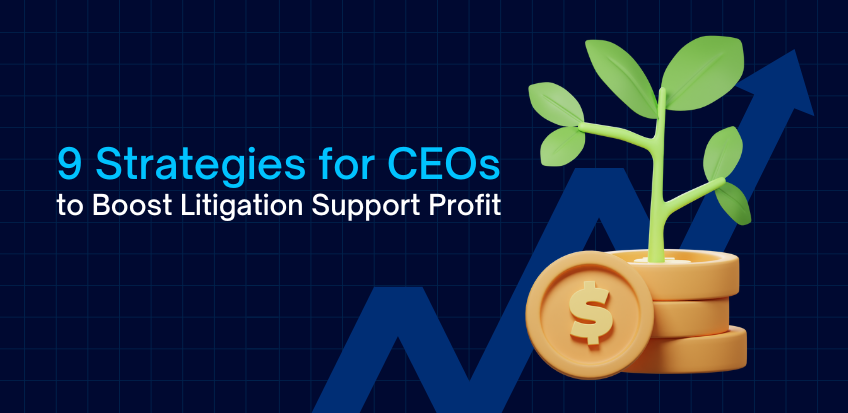Profitability isn’t just a target—it’s the backbone of sustainable growth in today’s business landscape. For CEOs in litigation support, driving profitability is both an opportunity and an imperative to stay competitive and secure lasting success. Explore these nine proven strategies to help you reach your profitability targets and create a foundation for sustained financial health.

1. Get to Know Your Profit Metrics
You already know the essentials: gross profit shows what’s left after covering the costs to deliver your service, while net profit reveals your final earnings after all operating expenses. But taking a closer, strategic look at these figures can uncover ways to enhance profitability in your litigation support business.
Start by zeroing in on each expense tied to service delivery. You’re likely covering the obvious ones, such as vendor or affiliate payments for tasks like service of process, as well as necessary non-negotiable tech expenses like web hosting. These costs aren’t just line items—they’re insights into where profit may be shrinking.
Even those smaller, easy-to-miss fees, like payment processing charges, need to be part of the sale cost if you want a clear read on profitability.
Meanwhile, keep your core delivery costs separate from other operating expenses such as rent, marketing, accounting, and supplies. By treating these groups distinctly, you’ll have a sharper view of where profitability truly lies.
CEO’s Takeaway: Think buckets, not bundles. Separate costs directly related to service delivery from other expenses. That way, you know exactly what it takes to fulfill each service—and what’s extra.

2. Dig Into Labor Costs
Labor-intensive services can eat into profits if you’re not careful. Among litigation support service businesses, expert review and concierge services are two services that can erase profits if not done right.
To make sure they’re operating in the black, factor in every bit of labor related to delivery of service as part of your cost of goods sold (COGS). That includes costs associated with dispatching a vendor, handling customer support calls, and anyone fulfilling tasks considered part of the service.
By tracking the details of employee output and setting targets, you get a much better idea of your costs. You also get a framework for making sure the employee cost per day fits within that target.
Here’s how to apply that framework to a labor-intensive service:
- If an employee costs you $180 a day, and you want to maintain a 60% profit margin for your concierge service, you’ll need a revenue of $1,000 per day.
That means…
- If you’re charging $50 for concierge service, you’ll need 20 orders each day to maintain a 60% profit margin.
If you track these figures regularly and discover your concierge service generates only $500 in daily revenue, you’ve got some adjusting to do.
To explore a fresh perspective about concierge service, read Pros and Cons of Concierge-Only Litigation Support.
CEO’s Takeaway: Measure labor by output. Be specific about how much value each hour of labor brings in and adjust as needed to maintain a good profit margin.

3. Prioritize High-Volume Services
High-volume services are often the most profitable services for one simple reason: The more you do something, the faster and more efficient it becomes.
If you’re trying to offer a service that your business doesn’t provide daily, it very well may not be a fit.
Expert review, for example, is a service that may not have steady demand and can be difficult to staff. If you’re not prepared to provide expert review efficiently, and have only spotty demand, it’s probably not mission critical to your product line.
If you are thinking about offering expert review or looking for tips on how to price it profitably, read The Price is Right: How to Set Strategic Pricing for Your Litigation Support Business.
CEO’s Takeaway: High-volume services equal high efficiency. The more frequently you provide a service, the more efficient it becomes, so de-prioritize low-demand services that can drain resources.

4. Price for Profit
To keep your business healthy, setting clear profit margin goals is a must. The CEO and owner of a successful California-based litigation support service business offers this suggestion: Aim for at least a 50% gross profit margin on service-based work.
This same CEO says if your litigation support service business is falling short of that 50% mark, it may be time to rethink pricing or negotiate lower costs with suppliers.
Profit margins, he says, are a CEO’s toolkit.
“You can adjust profit margins by raising prices, finding efficiencies, or reducing costs. Every percentage point counts, so small tweaks can add up to big results,” the business owner says.
Key Insight: Adjust pricing and costs to meet your margin goals. Stay flexible and make adjustments if your margin falls below target levels.
5. Track Profitability One Service at a Time
Tracking profitability down to each service level is key if you want to assure your business’s health. LegalConnect’s platform offers detailed reports that can help do that, allowing you to see revenue per job and understand which services are bringing in the most value.
Tracking these numbers isn’t just about seeing big totals; it’s about knowing your per-job profit.
For instance, if your business makes $100 on a particular service that costs $40 to fulfill, it captures a $60 gross profit. By knowing this number for every service, you have a clear sense of where to improve or adjust.
Here’s a good gauge of profitability among litigation support service companies:
Good: 10%-20% net profit
Better: 20%+ net profit
Best: 30%+ net profit
CEO’s Takeaway: Break down profits per service. Detailed profitability tracking allows you to see where each dollar is earned, and which services may need improvement.
6. Keep Operating Costs Low to Protect Your Net Profit
Virtually every business has to face down operating costs, and for litigation support service businesses that typically means rent, administrative salaries, software subscriptions, and the like. It’s crucial to keep these costs steady regardless of revenue.
So, if your business gets on a hot streak and revenue spikes, resist the temptation to live large. Instead, keep operating costs as stable as possible so that extra income translates to higher net profits.
Here’s a simple calculus to put that into perspective:
|
If your gross profit is 60% of revenue and you want a 10% net profit, keep operating costs under 50%. |
Using this approach, as revenue rises your profits increase instead of being redirected to cover extra expenses.
CEO’s Takeaway: Keep your fixed costs stable. When revenue rises and costs don’t go up, profits increase.

7. What’s in Your Service Lines?
It may seem elementary, but every CEO should have a keen interest in drilling down into the profitability of each service line.
This segmented view of services such as court filing and service of process, helps CEOs get a better sense of where profits are highest. Each service type has different costs and revenue profiles, so they shouldn’t all be treated the same.
A clear view of how each one performs also helps inform how you scale those areas and make changes if a service falls short.
CEO’s Takeaway: Segment service lines to see which ones drive profits. Breaking down profits by service line lets you target high-profit areas while adjusting or phasing out low-performers.
8. Review the Numbers Regularly
You’ll be hard pressed to find anyone in a litigation support service company more time-strapped than its chief executive. Difficult as it may be for these leaders to carve out time to keep tabs on the numbers, it’s critical for them to do so.
And do it regularly.
|
Regular check-ins help CEOs catch small problems before they turn into major issues. |
If your business is consistent, quarterly reviews may be enough. However, if you’re scaling or seeing fluctuations, monthly reviews will serve you better.
This cadence gives CEOs flexibility while ensuring they stay aware of the business’s financial health.
CEO’s Takeaway: Set a regular check-in schedule for profitability. Monthly or quarterly reviews help you spot trends and make quick adjustments when needed.

9. Use Reporting Tools for Insights
LegalConnect’s Reports feature provides a window on some of the most important performance and financial metrics related to your litigation support business. It’s an easy way to see at-a-glance where profits are strongest—in real time.
This, of course, helps improve the bottom line in several ways:
• Pinpoint Profits
Detailed reports on Case Fees, Invoice Payments, and more let you break down revenue per service, showing which areas are profitable and which may need a price check.
• Maintain Steady Cash Flow
Real-time data on fees and transactions keeps cash flow steady, so resources can be allocated where you need them most. Several helpful tips about mastering cash flow appear in the “Hello, My Name is Cash Flow” section of this article.
• Data-Driven Decision Making
With easy data exports, you can share insights across your team to support decisions on cost management, efficiency, and growth.
Tools like QuickBooks also make tracking revenue and expenses easier. A QuickBooks integration with accounting platforms and LegalConnect helps CEOs keep an eye on numbers.
As a result, CEOs can better understand service expenses and revenue categories, and may view each service line in the big picture or minute detail.
CEO’s Takeaway: Put LegalConnect Reports and other accounting tools to work monitoring finances. Make your data entry and categorization bulletproof so that cost and revenue tracking are accurate.
The Profitability Pivot
If you know your numbers and keep your focus on efficiency and volume, profitability becomes more than just a target—it becomes a natural part of your business strategy.
LegalConnect can help you sharpen that strategy with a high-performance technology platform versatile enough to serve customers, run your operations, and keep them profitable.
Contact us today! Call (800) 909-6859 or email support@legalconnect.com to schedule a demo!
